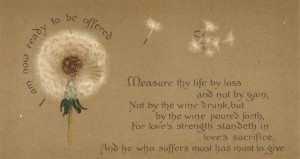“This film is a miniature masterpiece.”–Os Guinness…“The whole world should see this movie.”–Michelle Dockery…One of the most lovely and personally inspiring films ever–Lael
A new movie, Many Beautiful Things, introduces us to a true-life young beauty of means in Victorian England. An extraordinarily gifted artist, she is mentored and celebrated by John Ruskin, the leading art critic of the era, an Oxford professor and founder of its drawing school. He hailed her as one of the most potentially celebrated artists of her time. Ruskin’s challenge: “to give herself up to art.”
If she would dedicate herself to this great gift she would take her place among the cultural elite of England. She would change minds, as she had changed Ruskin’s, about the potential for women to paint great art.
She would also have an extraordinary platform from which to expand her work on behalf of poor and disenfranchised women–prostitutes whom she coaxed into the fledgling YWCA for shelter and job skills, the working women of London forced to eat their lunches on the streets, until she helped build London’s first public restaurant for women.
But another Voice was calling her.
In this beautifully executed documentary producer and director Laura Waters Hinson (As We Forgive) takes us on location and into Lilias’ art to see where her response would take her–away from the beauty and mentoring that Brantwood, Ruskin’s home in the Lake District, afforded her, away from the sparkling company of artists and thinkers who would gather there, away from the comfort of family and friends in London, away even from England.
She wrestled with Ruskin’s challenge and finally wrote, “I cannot give myself to painting in the way he means and continue still to ‘seek first the Kingdom of God.’” For Lilias that meant taking the gospel to the Muslims of North Africa.
Turned down by a mission board because of her health,  Lilias self-funded her journey to Algeria in the company of two friends. There she would pour out God’s love for Algerian Muslims for the next 40 years.
Lilias self-funded her journey to Algeria in the company of two friends. There she would pour out God’s love for Algerian Muslims for the next 40 years.
The heart and soul of the movie come from Lilias’ journals. As James Taylor once sang, it’s “how she thinks of where she’s been.” Lilias wraps beautiful words around the shared experience of anyone who truly wants to follow Christ.
When Hinson tried to imagine which actor’s voice would best capture the strength, pathos and vulnerability of Lilias’ words only one actor seemed to fit: Michelle Dockery (Lady Mary in Downton Abbey). Michelle was so taken by Lilias’ story and art that she agreed to be her voice (see the interview with Michelle here).
In addition to her journals, Lilias wrote parables– Parables of the Cross, Parables of the Christ-life. She illustrated all her works with scenes from England and Algeria, featuring the natural beauty of the deserts and lakes, dandelions and rocks, villages and people. She created memes before the internet, arranging her words over or  around her art.
around her art.
So, why don’t we know about this extraordinary woman?
Well, her Parables, published in the 1890s, went out of print long ago. Her exquisite sketchbooks and journals were never officially published. In her great moment of decision she intentionally chose obscurity over celebrity. Painting for an audience of One over exhibitions at galleries and museums.
Yes, she corresponded with Amy Carmichael for decades. And Elizabeth Elliott loved to read her out-of-print books on her radio program. But her legacy has been mostly confined to a rather small circle.
Then in 1999 one of that circle, Miriam Rockness, turned her life-long passion for hunting down all things Lilias into a biography: A Passion for the Impossible: The Life of Lilias Trotter. Miriam also hosts an extraordinary blog about Lilias where I discovered that Lilias’ words inspired one of my favorite songs: “So then turn your eyes upon Him, look full into His face and you will find that the things of earth will acquire a strange new dimness.”
 Building on Miriam’s work and the continued interest of a widening circle of followers, Hinson now brings Lilias’ story to an even larger audience. And as a student of faith and culture I believe the timing couldn’t be better. In Lilias’ writing and worshipful journaling she was so transparent, completely vulnerable– qualities highly valued in today’s postmodern culture.
Building on Miriam’s work and the continued interest of a widening circle of followers, Hinson now brings Lilias’ story to an even larger audience. And as a student of faith and culture I believe the timing couldn’t be better. In Lilias’ writing and worshipful journaling she was so transparent, completely vulnerable– qualities highly valued in today’s postmodern culture.
Also, she did not aspire to “Big.” She did not plant a church. She did not build an organization.
Throughout my life I have read many biographies, including missionary biographies– inspiring stories of risk, surrender and the amazing work of God that builds churches, orphanages, hospitals, even Veggie Tales. The narrative arc of Lilias’ story is quite different.
Lilias chose to love and serve in hiddenness, pouring out her life without reserve to the least of these in North Africa. She chose one-on-one face time with others, with God, her joy in his good gifts radiating from her sketches.
Reflecting on her decision to leave Ruskin’s circle, she wrote, “There are those to whom a blessed life of fruitfulness to God comes in a simple way, with seemingly no hard process of dying involved.”
That is what so inspired me about the movie, about her life. It was the simplicity of her motives. She did it for love. She did it for joy. You can feel the contagious sense of adventure with God. She would enter a new village and simply say, “Because I love God I’m here to meet you.” And people would eventually respond, “We have never been loved like that.”
She spoke of “a grand independence of soul” – the liberty for those who have nothing to lose because they have nothing to withhold.
Perhaps it impacted me so deeply because my own decision to go with Jack to the mission field back in 1980 was fraught with feelings of resignation and duty. I was Ruth— completely willing, “where you go I will go.” But leaving my family and friends and my faith and culture studies and in the States was so hard.
After I was diagnosed with RA it was back here in the States that God slowly moved me from relationship and obedience based on duty to desire. Having fought for the joy and found it, I’m smitten by the joy in Lilias’ life.
In Parables of the Cross, she painted and wrote about her joyful abandonment:
 “The word of the Lord came to me this morning through a dandelion plant…This dandelion has long ago surrendered its golden petals, and has reached its crowning stage of dying – the delicate seed-globe must break up now – it gives and gives till it has nothing left.
“The word of the Lord came to me this morning through a dandelion plant…This dandelion has long ago surrendered its golden petals, and has reached its crowning stage of dying – the delicate seed-globe must break up now – it gives and gives till it has nothing left.
What a revolution would come over the world – the world of starving bodies at home – the world of starving souls abroad, if something like this were the standard of giving; if God’s people ventured on ‘making themselves poor’ as Jesus did, for the sake of the need around.”
From her deathbed she wrote this final entry:
“We speak of the God of Love and the God of Peace – so seldom of the God of Joy. God is the God of joy, and we must drink in the spirit of His joy. Flowers are not a necessity – they are just an overflowing of  God’s gladness and if we look closely at each, it seems to reveal His joy each in a different way. . . the merry heart of the celandines and the pure simple happiness of the primrose and the shout of the daffodils’ golden trumpet. He didn’t promise us ease and comfort – but He did promise joy which we may have in the midst of any weight or heaviness that may be ours to bear.” 17 July 1928
God’s gladness and if we look closely at each, it seems to reveal His joy each in a different way. . . the merry heart of the celandines and the pure simple happiness of the primrose and the shout of the daffodils’ golden trumpet. He didn’t promise us ease and comfort – but He did promise joy which we may have in the midst of any weight or heaviness that may be ours to bear.” 17 July 1928
Featuring Lilias’ art in 3D animation, the movie is available on Amazon for purchase and Amazon Prime for rental. Screening dates here. (Released 3/8/16, 70 minutes, DVD $16.99) The film sparks discussion, especially about surrender, joy and legacy. In addition to private or small group viewing I can see it showing at a retreat or a Victorian high tea women’s event.


Intriguing. A must see. Thank you.
Lori, you and yours would love this. It will be showing at a film festival in Austin next wkend. Attic Film Festival at Alamo Draft House, Sat Apr 23rd at noon.
Thank you, Lael for reminding us of Lilias Trotter’s beautiful writing and artistry. Several of her books and poetry W/art are available from Disvovery House Publishets or go to ODB.org. I love your blog!!!
Thank you, Jennie. Yes, she really was a “gem in the desert.” Readers can find a list of her works that have been republished or copied here at her biographer’s blog
Lael, you have whet my appetite to learn more about Lilias. I feel that I must see this movie. Thank you for brining this to my attention!
You’re welcome, Harlan. I think you and your church would enjoy her story immensely.
Excellently articulated Lael! This documentary moves the soul!!!
Yes, it moved me deeply. I sensed God’s spirit speaking through Lilias’ life, empowered by all the prayers of the team that produced it. Sorry I missed greeting you there. Thanks for your comment.
Lael,
Thank you for writing such an eloquent post about such an eloquent author and artist from England’s Victorian past. Like you, I discovered Lilias through Elisabeth Elliot’s Gateway to Joy. I was struck by the profound quality of Trotter’s simplicity, the depth of her spiritual observations. I later was enthralled with Huffman’s four-color art book about Lilias called A Blossom in the Desert. It contains a little historical background by Huffman, very well written, and then Lilias’s own devotionals, often accompanied by the very watercolor paintings with which she illustrated them straight into her journals. This book is absolutely exquisite–a must-have. One will treasure it for years to come and pass it down through the future generations. It’s overflowing with wisdom and beauty. I had the rare privilege in July 2013 to visit the Arab World Ministry of Pioneers in Loughborough, Leicestershire, England to see firsthand what Huffman did–the breathtakingly beautiful illustrated journals of Lilias Trotter. I was afforded an afternoon to leaf through and luxuriate in their loveliness. Not only was I astounded to hold in my hands such artistry and to read words penned in another century, but whose truth and wisdom still ring true and offer guidance and inspiration today. Because of my own work in journal facilitation, the journals underscored to me the utter importance of writing down our story and our interactions with God. They testify to the power and permanence of the written word to continue to influence others for Christ long after we have left this world. I also arranged for a private viewing of more of Lilias’s paintings at the Ashmolean Museum in Oxford. Because she was not a popular artist, they have relegated her work to a more obscure part of the museum. When Many Beautiful Things was first released, I tried to organize a showing in St. Louis, to no avail. So I’m most grateful that the movie is available on DVD and highly recommend it to your readers. I love your idea about featuring it at a ladies’ Victorian Tea retreat! I also encourage your readers to look for many of her works, republished, available on Amazon. Recently I purchased one in facsimile. Here’s the one I love most: http://www.amazon.com/Blossom-Desert-Lilias-Trotter/dp/1572932562/ref=sr_1_3?s=books&ie=UTF8&qid=1460983127&sr=1-3&keywords=lilias+trotter While one may read this straight through, I have preferred to savor a devotional a day and just linger over loveliness. Thank you again for sharing, Lael. Your blog about Lilias is artful and inspirational.
Blessings,
Lynn
Lynn, what a great privilege to be up close and personal with Lilias’ work. So glad you had that opportunity. And thank you for the recommendation for A Blossom in the Desert. Readers can also find descriptions and links to her other works at Miriam’s blog on all things Lilias.
Yes, you make an excellent point about journaling. A timely reminder that not only are we more fully processing our thoughts and our worship, but also leaving a legacy. One day, when no one pays the annual fees, even our blogs will disappear. But journals will live on as long as some friend or family member wants to keep our thoughts and hearts close by.